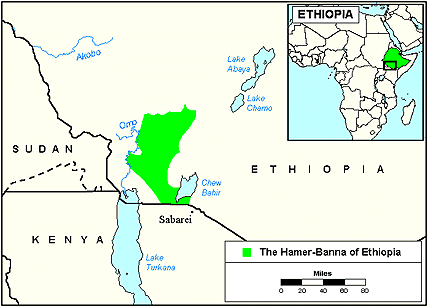|
|
Prayer Profile
The Hamer-Banna of Ethiopia
![[IMAGE]](../images3/0598.jpg) The 20,000 Hamer-Banna are Muslim shepherds living in the highlands of southwest Ethiopia. They are primarily located in the Gemu Gofa province, which is east of the Omo River and north of Lake Turkana. This area, called the Lower Omo region, has remained one of the most inaccessible and least developed part of East Africa.
The 20,000 Hamer-Banna are Muslim shepherds living in the highlands of southwest Ethiopia. They are primarily located in the Gemu Gofa province, which is east of the Omo River and north of Lake Turkana. This area, called the Lower Omo region, has remained one of the most inaccessible and least developed part of East Africa.
The Hamer-Banna consist of two separate ethnic groups, the Hamer and the Banna, who speak virtually the same language. Though they refer to themselves as either Hamer or Banna, they call their language Hamer-Banna. Most of the Hamer-Banna are cattle breeders. They belong to a group of culturally distinct people known as the Sidamo. Although they are racially mixed with the Bushman hunters who originally inhabited the region, they do not have any Bushman features. Authorities agree that they are clearly a mixture of the Caucasian and Negroid races.
What are their lives like?
The Hamer-Banna live in camps that consist of several related families. The families live in tents arranged in a circle, and the cattle are brought into the center of the camp at night. When the campsite is being set up, beds for the women and young children are built first; then the tent frame is built around it. The tents are constructed with flexible poles set in the ground in a circular pattern. The poles are bent upward, joining at the top, then tied. The structures are covered with thatch during the dry season and canvas mats during the rainy season. Men and older boys usually sleep on cots in the center of the camp, near the cattle.
Herds belonging to the Hamer-Banna consist mainly of cattle, although there are some sheep and goats. Camels are used for riding and as pack animals. Most Hamer-Banna plant fields of sorghum at the beginning of the rainy season before leaving on their annual nomadic journey. Some households also plant sesame and beans. Because the crops are usually left unattended, the yields are low. Few households grow enough grain to last through the year.
One striking characteristic of the Hamer-Banna men is that they indulge in elaborate hair-dressing. They wear a clay "cap" that is painted and decorated with feathers and other ornaments. Much time is spent in preparing the hair, and care must be taken to protect it from damage. This is one reason the men often sleep on small, cushioned stools. A well-dressed man will wear a toga-like cloth and carry a spear and a stool. Women also commonly wear colorful toga-like garments.
Men may marry as many women as they like, but only within their own tribe. A "bride price" of cattle and other goods is provided by the prospective husband and his near relatives. A typical household consists of a woman, her children, and a male protector. A man may be the protector of more than one household, depending on the number of wives he has. Also, men are sometimes assigned the responsibility of protecting a divorced woman, a widow, or the wife of an absent husband (usually his brother). Marriage celebrations include feasting and dancing. Young girls as well as boys are circumcised.
What are their beliefs?
The Hamer-Banna are 90% Sunni Muslim. They observe the five basic teachings of Islam, which include acknowledging that Allah is the only god, praying, fasting, giving alms to the poor, and making a pilgrimage to Mecca. However, many elements of their traditional religion are still practiced. For instance, they believe that natural objects (rocks, trees, etc.) have spirits. They also believe in jinnis, or spirits that are capable of assuming human or animal form and exercising supernatural influence over people.
What are their needs?
Only one missions agency is currently targeting the Hamer-Banna. Very few Christian resources are available in the Hamer-Banna language. More laborers and evangelistic tools are needed; however, prayer is the key to reaching them with the Gospel.
Prayer Points
- Pray for God to grant His favor and wisdom to the missions agency that is currently targeting the Hamer-Banna.
- Ask the Lord to call additional long-term workers to live and work among the Hamer-Banna.
- Ask God to strengthen, encourage, and protect the 409 known Hamer-Banna Christians.
- Pray that the Lord will give these converts boldness to share Jesus with their own people.
- Pray that God will raise up qualified linguists to translate the Bible into the Hamer-Banna language.
- Take authority over the spiritual principalities and powers that are keeping these precious people bound.
- Ask God to call forth prayer teams who will begin breaking up the soil through intercession.
- Ask the Lord to raise up strong local churches among the Hamer-Banna.

Statistics
Latest estimates from the World Evangelization Research Center.
THE PEOPLE
- People name: Hammer-Banna
- Country: Ethiopia
- Their language: Hammer-Banna
- Population:
- Largest religion:
- Christians: 2%
- Church members: 409
- Scriptures in their own language: None
- Jesus Film in their own language: None
- Christian broadcasts in their own language: None
- Mission agencies working among this people: 1
- Persons who have heard the Gospel: 4,300 (21%)
- Persons who have never heard the Gospel: 16,100 (79%)
THEIR COUNTRY
- Country: Ethiopia
- Population:
- Major peoples in size order:
- Major religions:
- Number of denominations: 29
© Copyright 1997
Bethany World Prayer Center
This profile may be copied and distributed without obtaining permission
as long as it is not altered, bound, published
or used for profit purposes.
![[HOME BUTTON]](../graphics/home.jpg)
![[CALENDAR BUTTON]](../graphics/calico.jpg)
![[LIST BUTTON]](../graphics/listico.jpg)
[Home]
[Calendar]
[Country List]
|